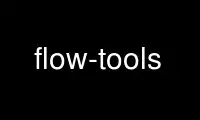
This is the command flow-tools that can be run in the OnWorks free hosting provider using one of our multiple free online workstations such as Ubuntu Online, Fedora Online, Windows online emulator or MAC OS online emulator
PROGRAM:
NAME
flow-tools — Tool set for working with NetFlow data.
DESCRIPTION
Flow-tools is library and a collection of programs used to collect, send, process, and
generate reports from NetFlow data. The tools can be used together on a single server or
distributed to multiple servers for large deployments. The flow-toools library provides
an API for development of custom applications for NetFlow export versions 1,5,6 and the 14
currently defined version 8 subversions. A Perl and Python interface have been
contributed and are included in the distribution.
Flow data is collected and stored by default in host byte order, yet the files are
portable across big and little endian architectures.
Commands that utilize the network use a localip/remoteip/port designation for
communication. "localip" is the IP address the host will use as a source for sending or
bind to when receiving NetFlow PDU's (ie the destination address of the exporter.
Configuring the "localip" to 0 will force the kernel to decide what IP address to use for
sending and listen on all IP addresses for receiving. "remoteip" is the destination IP
address used for sending or the expected address of the source when receiving. If the
"remoteip" is 0 then the application will accept flows from any source address. The
"port" is the UDP port number used for sending or receiving. When using multicast
addresses the localip/remoteip/port is used to represent the source, group, and port
respectively.
Flows are exported from a router in a number of different configurable versions. A flow
is a collection of key fields and additional data. The flow key is {srcaddr, dstaddr,
input, output, srcport, dstport, prot, ToS}. Flow-tools supports one export version per
file.
Export versions 1, 5, 6, and 7 all maintain {nexthop, dPkts, dOctets, First, Last, flags},
ie the next-hop IP address, number of packets, number of octets (bytes), start time, end
time, and flags such as the TCP header bits. Version 5 adds the additional fields
{src_as, dst_as, src_mask, dst_mask}, ie source AS, destination AS, source network mask,
and destination network mask. Version 7 which is specific to the Catalyst switches adds
in addition to the version 5 fields {router_sc}, which is the Router IP address which
populates the flow cache shortcut in the Supervisor. Version 6 which is not officially
supported by Cisco adds in addition to the version 5 fields {in_encaps, out_encaps,
peer_nexthop}, ie the input and output interface encapsulation size, and the IP address of
the next hop within the peer. Version 1 exports do not contain a sequence number and
therefore should be avoided, although it is safe to store the data as version 1 if the
additional fields are not used.
Version 8 IOS NetFlow is a second level flow cache that reduces the data exported from the
router. There are currently 11 formats, all of which provide {dFlows, dOctets, dPkts,
First, Last} for the key fields.
8.1 - Source and Destination AS, Input and Output interface
8.2 - Protocol and Port
8.3 - Source Prefix and Input interface
8.4 - Destination Prefix and Output interface
8.5 - Source/Destination Prefix and Input/Output interface
8.9 - 8.1 + ToS
8.10 - 8.2 + ToS
8.11 - 8.3 + ToS
8.12 - 8.5 + ToS
8.13 - 8.2 + ToS
8.14 - 8.3 + ports + ToS
Version 8 CatIOS NetFlow appears to be a less fine grained first level flow cache.
8.6 - Destination IP, ToS, Marked ToS,
8.7 - Source/Destination IP, Input/Output interface, ToS, Marked ToS,
8.8 - Source/Destination IP, Source/Destination Port,
Input/Output interface, ToS, Marked ToS,
The following programs are included in the flow-tools distribution.
flow-capture - Collect, compress, store, and manage disk space for exported flows from a
router.
flow-cat - Concatenate flow files. Typically flow files will contain a small window of 5
or 15 minutes of exports. Flow-cat can be used to append files for generating reports
that span longer time periods.
flow-fanout - Replicate NetFlow datagrams to unicast or multicast destinations. Flow-
fanout is used to facilitate multiple collectors attached to a single router.
flow-report - Generate reports for NetFlow data sets. Reports include source/destination
IP pairs, source/destination AS, and top talkers. Over 50 reports are currently
supported.
flow-tag - Tag flows based on IP address or AS #. Flow-tag is used to group flows by
customer network. The tags can later be used with flow-fanout or flow-report to generate
customer based traffic reports.
flow-filter - Filter flows based on any of the export fields. Flow-filter is used in-line
with other programs to generate reports based on flows matching filter expressions.
flow-import - Import data from ASCII or cflowd format.
flow-export - Export data to ASCII or cflowd format.
flow-send - Send data over the network using the NetFlow protocol.
flow-receive - Receive exports using the NetFlow protocol without storing to disk like
flow-capture.
flow-gen - Generate test data.
flow-dscan - Simple tool for detecting some types of network scanning and Denial of
Service attacks.
flow-merge - Merge flow files in chronoligical order.
flow-xlate - Perform translations on some flow fields.
flow-expire - Expire flows using the same policy of flow-capture.
flow-header - Display meta information in flow file.
flow-split - Split flow files into smaller files based on size, time, or tags.
Use flow-tools online using onworks.net services
